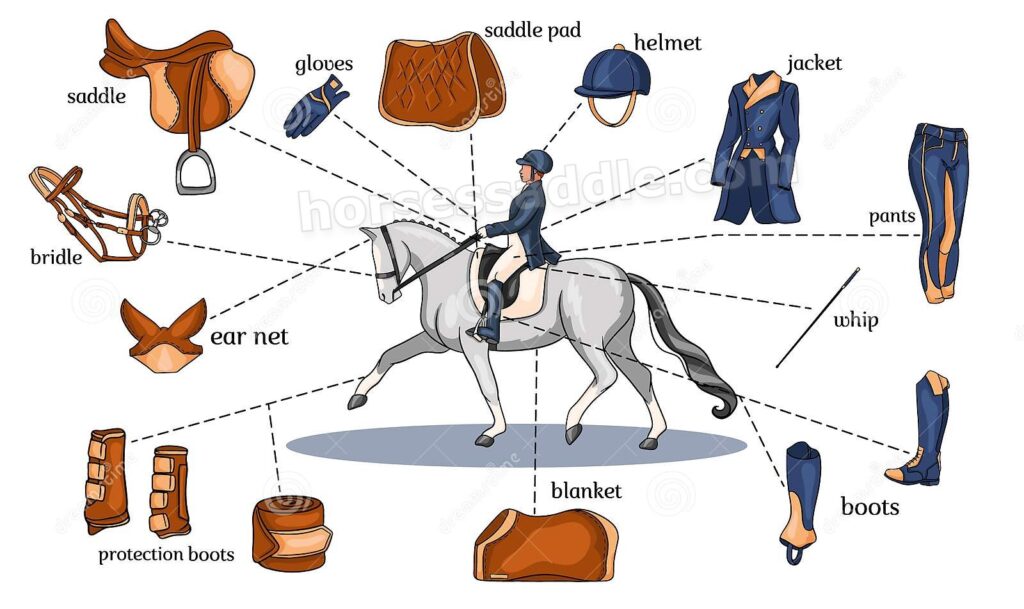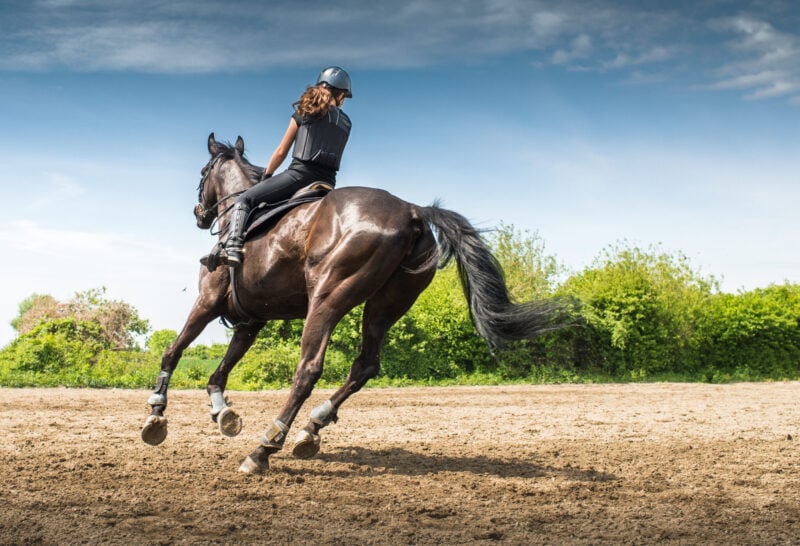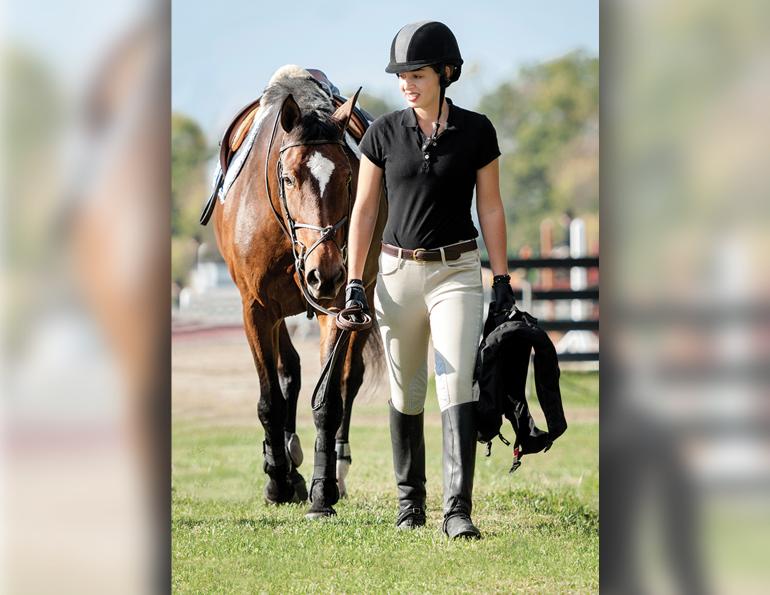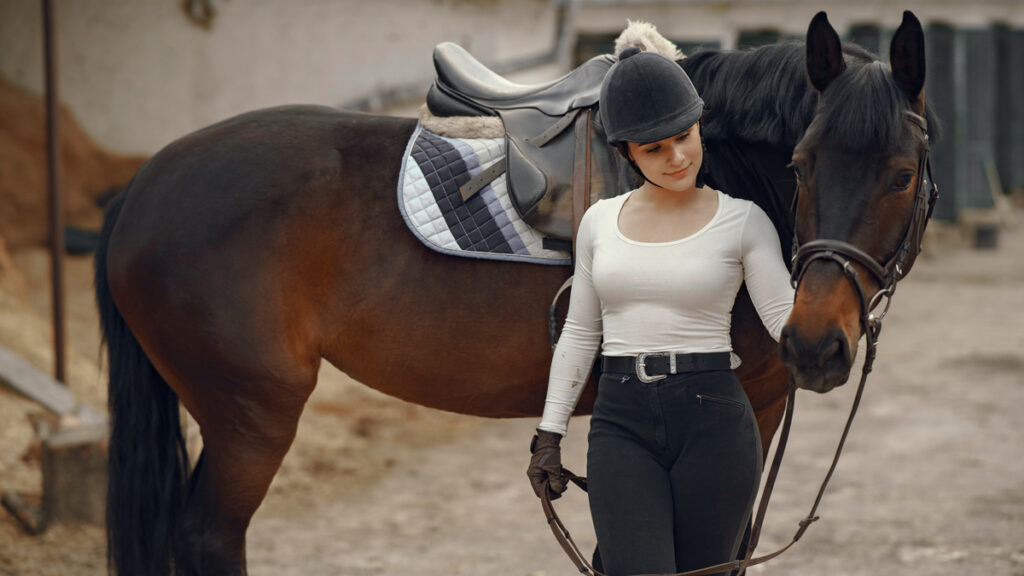Do you enjoy the thrilling experience of horseback riding? Well, if you do, then you know the importance of choosing the right equipment for a safe and enjoyable ride. But with so many options out there, it can be overwhelming to know where to start. Don’t worry, I’ve got you covered! In this article, we’ll dive into the details of how to choose the right horseback riding equipment, ensuring that you have all the information you need to make the best choices. So saddle up and get ready to learn!
When it comes to horseback riding, having the proper equipment is crucial for both your safety and the well-being of your horse. From saddles and bridles to helmets and boots, there are many factors to consider. We’ll discuss each piece of equipment in detail, providing you with insights on what to look for, how to ensure proper fit, and any additional features you may want to consider. By the end of this article, you’ll have a thorough understanding of how to choose the right horseback riding equipment that suits your needs and preferences. So, let’s get started and make sure you’re well-equipped for your next adventure on horseback!
How to Choose the Right Horseback Riding Equipment
Horseback riding is a thrilling and enjoyable activity that requires the use of proper equipment for both the rider and the horse. Whether you are a beginner or an experienced rider, choosing the right horseback riding equipment is essential for your safety, comfort, and performance. In this article, we will discuss the different types of horseback riding equipment, considerations when choosing them, essential equipment for the rider and the horse, additional accessories, factors to consider when buying, safety tips, common mistakes to avoid, and tips for maintaining and caring for the equipment. Let’s dive in!

Different Types of Horseback Riding Equipment
Before delving into the considerations and essential equipment, let’s first understand the various types of horseback riding equipment available.
English Riding Equipment
English riding equipment, also known as English tack, is specifically designed for disciplines such as dressage, eventing, show jumping, and hunter/jumper riding. These disciplines focus on precision, elegance, and finesse. Common English riding equipment includes close contact saddles, snaffle bridles, and non-slip saddle pads.
Western Riding Equipment
Western riding equipment is used in Western disciplines such as barrel racing, reining, and western pleasure. It is known for its distinct look and functionality. Western saddles are designed to provide more stability and support during long rides, and western bridles often feature a single rein and a curb bit.
Trail Riding Equipment
Trail riding equipment is suitable for riders who enjoy exploring the outdoors and going on long rides on various terrains. It includes comfortable saddles with extra padding, durable bridles, and saddlebags for carrying essentials such as water, snacks, and a first aid kit.
Jumping Equipment
Jumping equipment is specifically designed for riders who participate in show jumping or eventing. These disciplines involve jumping over obstacles, and therefore, safety and functionality are crucial. Jumping saddles have a forward-cut flap to allow for proper leg positioning, and bridles may include a flash or figure-eight noseband for additional control.
Dressage Equipment
Dressage equipment is used in the discipline of dressage, which focuses on precise and controlled movements. Dressage saddles have a deep seat and long, straight flaps to allow the rider to maintain a correct position. Double bridles with a snaffle and a curb bit are often used to achieve optimal communication and control.
Considerations When Choosing Horseback Riding Equipment
When selecting horseback riding equipment, several factors should be taken into consideration to ensure a proper fit and optimal performance. These considerations include the rider’s experience level, the horse’s size and breed, the specific riding discipline, comfort and fit, durability and quality, and safety features.
Rider’s Experience Level
The rider’s experience level plays a significant role in choosing the right equipment. Beginners may require more support and stability, while advanced riders may prefer equipment that allows for greater freedom of movement and responsiveness.
Horse’s Size and Breed
It is essential to consider the horse’s size and breed when selecting equipment. Different breeds may have varying body proportions and require specialized equipment. Additionally, the horse’s size will determine the appropriate saddle size, bridle fit, and girth or cinch length.
Riding Discipline
The specific riding discipline will dictate the type of equipment needed. Each discipline requires equipment that facilitates optimal performance and communication between the rider and the horse.
Comfort and Fit
Comfort and fit are crucial aspects to consider for both the rider and the horse. Ill-fitting equipment can cause discomfort, pain, and even injuries. It is important to ensure that the saddle, bridle, girth or cinch, and other equipment fit properly and allow for freedom of movement.
Durability and Quality
Investing in durable and high-quality equipment is essential for long-term use and safety. Well-made equipment is less likely to break or malfunction, providing peace of mind and a more enjoyable riding experience.
Safety Features
Safety should always be a top priority when selecting horseback riding equipment. Look for features such as sturdy construction, reflective elements for visibility, and proper padding in helmets and saddle pads to ensure maximum protection.

Key Horseback Riding Equipment for the Rider
Now let’s take a closer look at the essential horseback riding equipment for the rider. These items are crucial for protection, comfort, and performance.
Helmet
A properly fitting and certified helmet is the most important piece of equipment for any rider. It protects the head from potential injuries in the event of a fall or impact. Look for helmets that meet safety standards and provide a secure fit.
Riding Boots
Riding boots are designed to provide support, grip, and protection to the rider’s feet and lower legs. They should have a heel to prevent the foot from slipping through the stirrups and should be comfortable for long hours in the saddle.
Riding Pants
Riding pants, also known as breeches, are specifically designed for horseback riding. They provide grip, flexibility, and comfort while allowing the rider’s leg to maintain close contact with the horse. Look for pants made from stretchy and breathable materials.
Gloves
Riding gloves protect the rider’s hands from blisters, rubs, and friction. They also improve grip on the reins and help maintain a steady and comfortable contact with the horse’s mouth.
Riding Shirt
A suitable riding shirt should be lightweight, breathable, and moisture-wicking for maximum comfort during rides. Depending on the weather, riders may opt for long sleeves, short sleeves, or riding jackets.
Spurs and Whip (if needed)
Spurs and a whip can be optional additions to the rider’s equipment, depending on the discipline or the individual horse’s needs. If used, it is essential to learn how to use them correctly and ethically.
Essential Horseback Riding Equipment for the Horse
Equally important as the rider’s equipment is the horse’s equipment. Here are the essential items for the horse.
Saddle
The saddle is perhaps the most essential piece of equipment for the horse. It should fit properly and distribute the rider’s weight evenly to prevent discomfort or back issues. Different disciplines may require specific types of saddles, so choose accordingly.
Bridle
The bridle is used for communication and control between the rider and the horse. It includes the headstall, bit, and reins. The bridle should fit comfortably and allow for clear and subtle communication.
Girth or Cinch
The girth or cinch secures the saddle in place on the horse’s back. It should be the right size and properly adjusted to ensure the saddle’s stability without causing discomfort or restriction.
Saddle Pad
A saddle pad provides extra cushioning and shock absorption for the horse’s back. It should be breathable, durable, and properly sized to prevent rubbing or pressure points.
Stirrups and Stirrup Leathers
Stirrups and stirrup leathers provide support and stability for the rider’s feet and legs. The length of the stirrup leathers should be adjusted to the rider’s leg length and allow for a proper position.
Reins
The reins connect the rider’s hands to the horse’s mouth and are used for steering and communication. They should be comfortable to hold, made from durable materials, and appropriate for the riding discipline.

Additional Horseback Riding Accessories
In addition to the essential equipment, there are various accessories that can enhance the horseback riding experience. These accessories serve specific purposes and may be beneficial depending on the rider’s preferences and the horse’s needs. Let’s explore some of them.
Horse Blankets
Horse blankets are used to protect horses from cold temperatures, wind, rain, and insects. There are different types of blankets available, such as turnout blankets, fly sheets, and cooler sheets, each designed for specific purposes.
Horse Boots
Horse boots provide protection and support to the horse’s legs during riding or turnout. Different types of boots include splint boots, bell boots, and brushing boots, each designed to address specific needs and potential injuries.
Martingale
A martingale is a piece of equipment used to control the position of the horse’s head and neck during riding. It can help address issues such as head tossing or excessive raising of the head.
Breastplate
A breastplate is used to prevent the saddle from slipping backward on the horse’s back. It helps to stabilize the saddle and provides added security, especially during jumping or fast-paced riding.
Horse Grooming Tools
Proper grooming is an essential part of horse care. Grooming tools such as brushes, combs, hoof picks, and shedding blades are used to keep the horse’s coat clean, free of debris, and healthy.
Factors to Consider When Buying Horseback Riding Equipment
When purchasing horseback riding equipment, it is important to consider several factors to ensure you are making the right choice. These factors include your budget, brand reputation, proper sizing and fitting, material quality, personal preferences, and reviews and recommendations.
Budget
Determine your budget for horseback riding equipment before starting your search. Prices can vary significantly depending on the brand, quality, and type of equipment.
Brand Reputation
Research different brands and their reputation in the equestrian community. Look for brands that offer high-quality products known for their durability and performance.
Proper Sizing and Fitting
Ensure that the equipment you choose is the correct size and fit for both the rider and the horse. Ill-fitting equipment can cause discomfort and potential issues during riding.
Material Quality
Check the quality of the materials used in the equipment. The durability and longevity of your equipment depend on high-quality construction and materials.
Personal Preferences
Consider your personal preferences when choosing horseback riding equipment. Factors such as color, design, and style may be important to you.
Reviews and Recommendations
Read reviews and seek recommendations from experienced riders or professionals in the equestrian field. Their insights can provide valuable information and help you make an informed decision.

Where to Buy Horseback Riding Equipment
Finding the right place to purchase horseback riding equipment is crucial. Here are some options to consider:
Local Tack Shops
Local tack shops often carry a wide range of horseback riding equipment and offer personalized assistance and fitting services. They allow you to see and try the equipment in person before making a purchase.
Online Retailers
Online retailers provide a convenient way to browse and purchase horseback riding equipment from the comfort of your home. Make sure to research the retailer’s reputation, read reviews, and check their return policies before making a purchase.
Second-Hand Stores
Second-hand stores or online marketplaces can be a great option if you are on a budget or looking for specific equipment. However, thoroughly inspect the used equipment for any damage or excessive wear before purchasing.
Directly from Manufacturers
Some equipment manufacturers sell their products directly through their websites or authorized dealers. Buying directly from the manufacturer ensures that you are getting genuine products and may offer additional perks such as warranties or customer support.
Essential Safety Tips for Using Horseback Riding Equipment
Safety should always be a top priority when it comes to horseback riding. Follow these essential safety tips when using horseback riding equipment:
Always Wear a Helmet
Wearing a properly fitted and certified helmet is crucial for protecting your head in the event of a fall or impact. Make sure your helmet meets current safety standards and replace it if it has been involved in a fall or is showing signs of wear and tear.
Ensure Proper Saddle Fit
A well-fitting saddle is essential for the horse’s comfort and performance. Improper saddle fit can cause discomfort, back pain, and even permanent damage. Consult with a professional saddle fitter or a knowledgeable instructor to ensure your saddle fits correctly.
Regularly Inspect and Maintain Equipment
Regularly inspect your horseback riding equipment for any signs of damage or wear and tear. Check for loose stitching, cracking leather, or rusted metal parts. Perform routine maintenance such as cleaning and conditioning leather to prolong the equipment’s lifespan.
Use Appropriate Safety Gear
In addition to wearing a helmet, consider using other safety gear such as riding vests or body protectors, knee and elbow pads, and reflective gear for increased visibility, especially when riding on roads or during low-light conditions.
Follow Proper Horse Handling Techniques
Understanding and practicing proper horse handling techniques is crucial for your safety and the safety of others. Learn how to approach, lead, groom, tack, mount, and dismount a horse safely to minimize the risk of accidents or injuries.

Common Mistakes to Avoid When Choosing Horseback Riding Equipment
When choosing horseback riding equipment, common mistakes can be costly and impact your riding experience. Here are some common mistakes to avoid:
Buying Cheap and Poor-Quality Gear
Investing in high-quality equipment may require a larger upfront cost, but it will provide better performance, comfort, and durability in the long run. Buying cheap and poor-quality gear can result in discomfort, quick deterioration, and potential safety hazards.
Ignoring Proper Saddle Fit
Improper saddle fit can lead to discomfort, pain, and even physical issues for both the horse and the rider. Ignoring the importance of proper saddle fit can negatively impact performance and result in long-term damage.
Neglecting Safety Features
Choosing horseback riding equipment without considering important safety features can increase the risk of accidents and injuries. Always prioritize safety when selecting equipment for both the rider and the horse.
Choosing the Wrong Type of Equipment for the Discipline
Each riding discipline has specific equipment requirements to ensure optimal performance and communication. Choosing the wrong type of equipment for the discipline can hinder your progress and negatively impact your riding experience.
Not Considering the Horse’s Comfort
The horse’s comfort should always be a top priority when choosing equipment. Ill-fitting or uncomfortable equipment can lead to resistance, behavioral issues, and reduced performance. Ensure that the equipment is suitable for your horse’s specific needs and body type.
Tips for Maintaining and Caring for Horseback Riding Equipment
Proper maintenance and care are essential to prolong the lifespan of horseback riding equipment. Here are some tips to follow:
Clean and Condition Leather Regularly
Leather equipment such as saddles, bridles, and boots should be cleaned and conditioned regularly to maintain their quality. Use leather cleaners and conditioners specifically designed for equestrian products to avoid damaging the leather.
Store Equipment in a Dry and Well-Ventilated Area
Proper storage is important to prevent damage and deterioration to your equipment. Store your equipment in a dry and well-ventilated area to avoid mold, mildew, and rust. Keep leather items away from direct sunlight to prevent discoloration.
Inspect for Damages or Wear Regularly
Perform regular inspections of your equipment to check for any signs of damage or wear. Pay attention to stitching, buckles, straps, and padding. Replace or repair any damaged or worn-out parts promptly.
Replace Worn-Out or Damaged Equipment
When your equipment starts to show signs of significant wear or damage, it is time to replace it. Continuing to use damaged equipment can compromise your safety and the horse’s comfort.
Follow Manufacturer’s Instructions for Care
Manufacturers often provide specific care instructions for their products. Follow these instructions to ensure proper care and maintenance, as improper care can void warranties or cause damage.
Understanding the Importance of Proper Horseback Riding Equipment
Choosing the right horseback riding equipment is essential for various reasons. Let’s explore the importance of proper equipment:
Enhances Rider’s Safety
Properly fitting and certified equipment, such as helmets and safety vests, significantly increase the rider’s safety and reduce the risk of injuries in the event of a fall or accident.
Improves Horse’s Comfort and Performance
Well-fitted saddles, bridles, and other equipment contribute to the horse’s comfort and well-being, enabling them to perform at their best.
Facilitates Effective Communication Between Horse and Rider
The right equipment, such as properly adjusted reins and bits, allows for clear and effective communication between the rider and the horse. It helps to establish a harmonious partnership and improves overall performance.
Prevents Injuries and Accidents
Choosing equipment with safety features and maintaining it properly helps prevent injuries and accidents during horseback riding. Ensuring proper saddle fit and using protective gear reduce the risk of discomfort or harm to both the rider and the horse.
Ensures Enjoyable and Successful Riding Experiences
Having the right horseback riding equipment enhances the overall riding experience. It allows the rider and the horse to feel comfortable, confident, and safe, resulting in enjoyable and successful rides.
Personalizing Horseback Riding Equipment
Personalizing horseback riding equipment can add a touch of individuality and style. Some ways to personalize your equipment include choosing colors and designs, customizing with initials or logos, matching equipment to your riding attire, and adding decorative elements such as saddle charms or monograms.
Factors to Consider When Upgrading Horseback Riding Equipment
As you progress in your riding journey, upgrading your horseback riding equipment may become necessary. Here are some factors to consider when deciding to upgrade:
Advancement in Riding Skills
If you have advanced in your riding skills, you may need equipment that can accommodate your increased level of control and precision.
Change in Riding Discipline
If you decide to switch or add a new riding discipline to your repertoire, you might need specific equipment tailored to that discipline’s requirements and demands.
Desire for Better Performance
Upgrading equipment can contribute to improved performance. As you strive to reach new goals and improve your riding, consider upgrading to equipment that provides better support, balance, and communication with the horse.
Equipment Wear and Tear
When your equipment starts showing significant wear or damage, it is advisable to upgrade rather than continue using it. Worn-out equipment can compromise safety and hindrance performance.
Conclusion
Choose your horseback riding equipment wisely to ensure your safety, comfort, and success in the saddle. Consider the various types of equipment available, as well as your experience level, the horse’s needs, and the specific riding discipline. Invest in high-quality and properly fitted equipment, and always prioritize safety features. Regularly inspect and maintain your equipment, and replace worn-out or damaged items promptly. By choosing the right equipment and caring for it properly, you can enhance your riding experience, communicate effectively with your horse, and enjoy many memorable rides in the future.
Remember, horseback riding is a wonderful adventure, and having the right equipment is essential for a safe and enjoyable journey. Happy riding!
Disclaimer: The information in this article is for educational purposes only and should not replace professional guidance. Always consult a qualified instructor or equestrian professional for personalized advice and recommendations.